

Bringing Inquiry-Based Learning Into Your Class. In the shallow end of the Types of Student Inquiry pool, Structured Inquiry gives the teacher control of the essential question, the starting point—for example, “What defines a culture?”
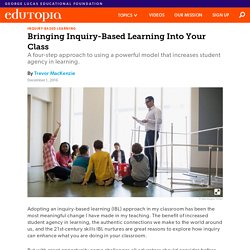
Or “What is the importance of the scientific method?” These questions are not answered in a single lesson and do not have a single answer, and, in fact, our understanding of an essential question may change over time as we research it. In Structured Inquiry, the teacher also controls specific learning activities, the resources students will use to create understanding, and the summative assessment learners will complete to demonstrate their understanding.
In Controlled Inquiry, the teacher provides several essential questions. Learners unpack several resources predetermined by the teacher to provide valuable context and rich meaning relative to the essential questions. Bringing Inquiry-Based Learning Into Your Class... Bringing Inquiry-Based Learning Into Your Class. Types of Student Inquiry - Simplek12. 35 Educational Resources to Encourage Inquiry & Inventive Thinking. This is a sponsored post.

I’ve scoured the internet, including all of my favourite social media sites, to bring you a fantastic collection of online inquiry and inventive thinking resources that I know will inspire and motivate both you and your students. The collection includes Lego, science, practical activity ideas, engineering, videos, animation, technology and a tonne of fun facts – so there is sure to be something for everyone! Sean Kenney Lego Certified Master Builder’s YouTube Channel: Best-selling author and artist, Sean Kenney, uses LEGO toys to build anything and everything you can imagine.
CSIRO Crest: CREativity in Science and Technology (CREST) is an Australian non-competitive awards program supporting students to design and carry out their own open-ended science investigation or technology project. Pinterest is a veritable smorgasbord of great ideas across all grades and subject areas. How to Design a Classroom Built on Inquiry, Openness and Trust. Teachers who are interested in shifting their classrooms often don’t know where to start.
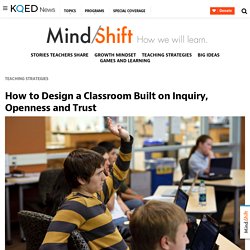
It can be overwhelming, frightening, and even discouraging, especially when no one else around you seems to think the system is broken. A question I’m asked often is, “Where should a teacher begin?” Should teachers just let students go or is there a process to good student-centered inquiry? I’ve reflected on this a fair amount, and I think small strategic steps are the key. I think letting students “go” without any structure will likely create failure, especially if students haven’t spent much time collaborating. 35 Educational Resources to Encourage Inquiry & Inventive Thinking. The Challenges and Realities of Inquiry-Based Learning.
Inquiry Learning Teaching Strategies Getty By Thom Markham Teachers in a rural southeast Michigan high school were recently discussing the odd behavior of the senior class.
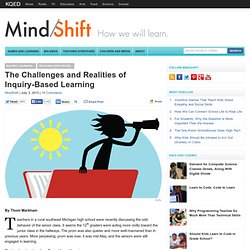
It seems the 12th graders were acting more civilly toward the junior class in the hallways. The prom was also quieter and more well-mannered than in previous years. The teachers’ explanation: Project-based learning. Here’s the back story. Stories like this are about to become more important to educators. Reinventing School From the Ground Up For Inquiry Learning. By Thom Markham A grave miscalculation exists in the minds of many educators: That inquiry-based learning, project based learning, and 21st century competencies can flourish in industrial model schools.
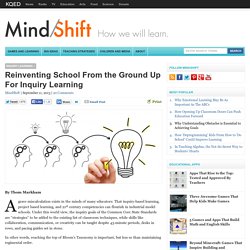
Under this world view, the inquiry goals of the Common Core State Standards are “strategies” to be added to the existing list of classroom techniques, while skills like collaboration, communication, or creativity can be taught despite 43-minute periods, desks in rows, and pacing guides set in stone. In other words, reaching the top of Bloom’s Taxonomy is important, but less so than maintaining regimental order. But what we know—from industry and neuroscience—is that organizational structure, environment, and human performance are deeply intertwined.
It is inevitable that schools must be completely redesigned if society wants to tap the wellsprings of creativity and exploration that the industrial system subdues. This redesign issue looms large. The Inquiry Process, Step By Step. Educationalresearchtechniques. Inquiry learning is form of indirect instruction.
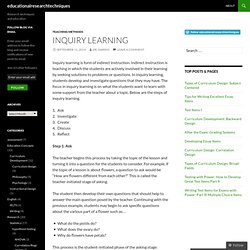
Indirect instruction is teaching in which the students are actively involved in their learning by seeking solutions to problems or questions. In inquiry learning, students develop and investigate questions that they may have. The focus in inquiry learning is on what the students want to learn with some support from the teacher about a topic. 20 Questions To Guide Inquiry-Based Learning. 20 Questions To Guide Inquiry-Based Learning Recently we took at look at the phases of inquiry-based learning through a framework, and even apps that were conducive to inquiry-based learning on the iPad.
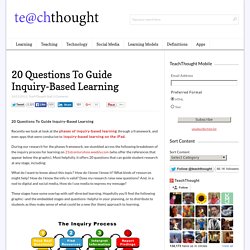
During our research for the phases framework, we stumbled across the following breakdown of the inquiry process for learning on 21stcenturyhsie.weebly.com (who offer the references that appear below the graphic). Most helpfully, it offers 20 questions that can guide student research at any stage, including: What do I want to know about this topic? How do I know I know it? These stages have some overlap with self-directed learning. References Cross, M. (1996). Kuhlthau, C., Maniotes, L., & Caspari, A. (2007). The Challenges and Realities of Inquiry-Based Learning. Inquiry Learning Ideas for Math and Science With iPads. Digital Tools Laurie Sullivan/Flickr By Sam Gliksman The following is the second of a series of excerpts from Gliksman’s book iPad in Education for Dummies.

We tend to split science and humanities as though they were separate branches of life. The Challenges and Realities of Inquiry-Based Learning. The Challenges and Realities of Inquiry-Based Learning. Inquiry Learning Ideas for Math and Science With iPads. Creating Classrooms We Need: 8 Ways Into Inquiry Learning.
If kids can access information from sources other than school, and if school is no longer the only place where information lives, what, then happens to the role of this institution?
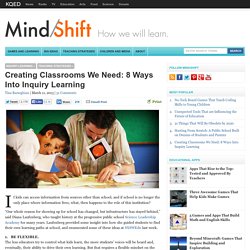
“Our whole reason for showing up for school has changed, but infrastructure has stayed behind,” said Diana Laufenberg, who taught history at the progressive public school Science Leadership Academy for many years. Laufenberg provided some insight into how she guided students to find their own learning paths at school, and enumerated some of these ideas at SXSWEdu last week. 1. BE FLEXIBLE. The less educators try to control what kids learn, the more students’ voices will be heard and, eventually, their ability to drive their own learning.
Laufenberg recalled a group of tenacious students who continued to ask permission to focus their video project on the subject of drugs, despite her repeated objections. 2. Laufenberg’s answer: Get them curious enough in the subject to do research on their own. 3. 4. 5. 6. 7. The Challenges and Realities of Inquiry-Based Learning. Is School Enough? Documentary Film Delves In. A documentary film premiering on public television today — “Is School Enough?”
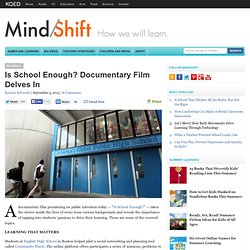
— takes the viewer inside the lives of teens from various backgrounds and reveals the importance of tapping into students’ passions to drive their learning. These are some of the covered topics. Students at English High School in Boston helped pilot a social networking and planning tool called Community Planit. The online platform offers participants a series of missions, problems to solve and questions to answer about how the school district could improve and meet student needs better. As a player completes missions, he receives tokens to spend on the priorities he’d most like to see in school. “I’m always trying to keep my ear to the ground to get my kids involved with meaningful projects,” said Xavier Rozas, instruction technology coordinator at English High School. In fact, the English High School students’ engagement with Community Planit was crucial to its success as a planning tool for the district.
Inquiry Learning Vs. Standardized Content: Can They Coexist? By Thom Markham As Common Core State Standards are incorporated from school to school across the country, educators are discussing their value. It may seem that educators are arguing over whether the CCSS will roll out as a substitute No Child Left Behind curriculum or as an innovative guide to encourage inquiry rather than rote learning.
In reality, as time will prove, we’re arguing over whether content standards are still appropriate. Curious Homework: An Inquiry Project for Students and Parents. Photo credit: iStockphoto International educator Scot Hoffman is a big believer in the power of curiosity to drive learning. After nearly two decades of teaching around the globe, he also realizes that school isn't always so hospitable to inquiring minds. 5 Tools to Help Students Learn How to Learn.
Helping students learn how to learn: That’s what most educators strive for, and that’s the goal of inquiry learning. That skill transfers to other academic subject areas and even to the workplace where employers have consistently said that they want creative, innovative and adaptive thinkers. Inquiry learning is an integrated approach that includes kinds of learning: content, literacy, information literacy, learning how to learn, and social or collaborative skills. Students think about the choices they make throughout the process and the way they feel as they learn. Those observations are as important as the content they learn or the projects they create. “We want students thinking about their thinking,” said Leslie Maniotes a teacher effectiveness coach in the Denver Public Schools and one of the authors of Guided Inquiry: Learning in the 21st Century.
Why Inquiry Learning is Worth the Trouble. Visualization of SLA principal Chris Lehmann's 2011 talk: guiding kids' to thinking about how they think. Nearly seven years after first opening its doors, the Science Leadership Academy public magnet high school* in Philadelphia and its inquiry-based approach to learning have become a national model for the kinds of reforms educators strive towards. But in a talk this past weekend at EduCon 2.5, the school’s sixth-annual conference devoted to sharing its story and spreading its techniques, Founding Principal Chris Lehmann insisted that replicating his schools approach required difficult tradeoffs.
“This is not easy. This is not perfect,” Lehmann told a crowd of devotees stuffed inside one of the Center City school’s second-floor science classrooms on Sunday. “There are really challenging pieces of this, and we should be OK with this.” “Inquiry means living in the soup. “To me it comes down to process,” Lehmann said. Seeing, wondering, theorizing, learning: Inquiry-based instruction with Kishia Moore. There they go — Mitchell County teacher Kishia Moore and her class of seventeen first graders — up Gem Mountain not far from their school, Greenlee Primary, to pan for gemstones for use in their NC Standard Course of Study-mandated science unit on minerals.
And here the kids come, back down the hill, dirty, damp, and hauling impossibly heavy — for the kids’ size, that is — loads of rocks that during the next five to six weeks, they will study, sort, measure, weigh, scratch, break if possible, discuss, compare, draw pictures of, polish in noisy rock tumblers, and, ultimately, fashion into items of jewelry. If Ms. Moore employed traditional teaching methods, her next tasks would be to explain the sorting and measuring processes and then direct her students through those processes.
Ms. The definition Ms. Impact-research-briefs-inquiry-based-teaching. Inquiry Based Teaching: Reasons To Use Inquiry Based Teaching. Reading Comprehension and Considerate Text, Teaching Today, Glencoe Online. Inquiry based classroom. Galileo Educational Network. Creating Classrooms We Need: 8 Ways Into Inquiry Learning. CBS_InquiryBased. Primas-project. Examples of Inquiry Based Lessons. TWT: Inquiry-based Learning Strategy. Inquiry-Based Learning. Inquiry Based Learning Projects on Pinterest. Learning Science Through Inquiry. Frequently Asked Questions. OER Commons. Investigating Animals: Using Nonfiction for Inquiry-based Research. ReadWriteThink couldn't publish all of this great content without literacy experts to write and review for us.
Inquiry-Based Lesson Plans. Inquiry-based Learning: Demonstration. JIBLM.org - Journal of Inquiry-Based Learning in Mathematics - IBL Course Notes in Mathematics. Inquiry-based Learning - About Us. What is IBL? - The Academy of Inquiry Based Learning. Inquiry-Based Learning (IBL) is a student-centered method of teaching Mathematics. At the college mathematics level one of the forms of IBL is the Modified Moore Method, named after R. L. Moore. AEC394/WC075: What Is Inquiry-Based Instruction? Anna J. Warner and Brian E. Myers2. Introduction. Inquiry Based Learning. Inquiry-based learning. Inquiry-based learning (also enquiry-based learning in British English)[1] starts by posing questions, problems or scenarios—rather than simply presenting established facts or portraying a smooth path to knowledge. The process is often assisted by a facilitator. Inquiry-based Learning: Explanation.
BBB%20Balance%20Healey. A101_Edelson_etal_99. Create a Culture of Questioning and Inquiry. I have often suggested to teachers that when students have access to technology, whether it is provided by the school in a 1:1, BYOD, or simply the smart phone in their pocket, there should never be a question that goes unanswered –or un-followed. These are teachable moments for how to effectively search for information (information literacy & digital literacy) and allowing the time for students to explore connected ideas brings more depth to the learning, and allows students to make sense of things as they combine new information what they already know and understand, as well as to identify misunderstandings.
Questioning leads to synthesis. It also makes the learning personal for students. Curious Homework: An Inquiry Project for Students and Parents. 36 Core Teacher Apps For Inquiry Learning With iPads. How BYOD Programs Can Fuel Inquiry Learning. 4 Phases of Inquiry-Based Learning: A Guide For Teachers.